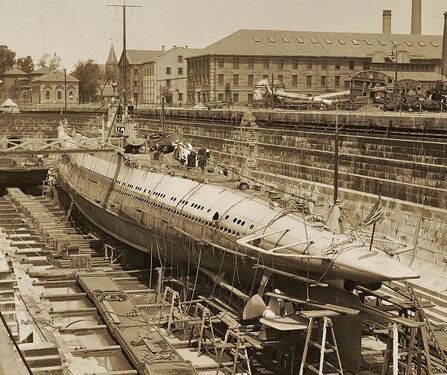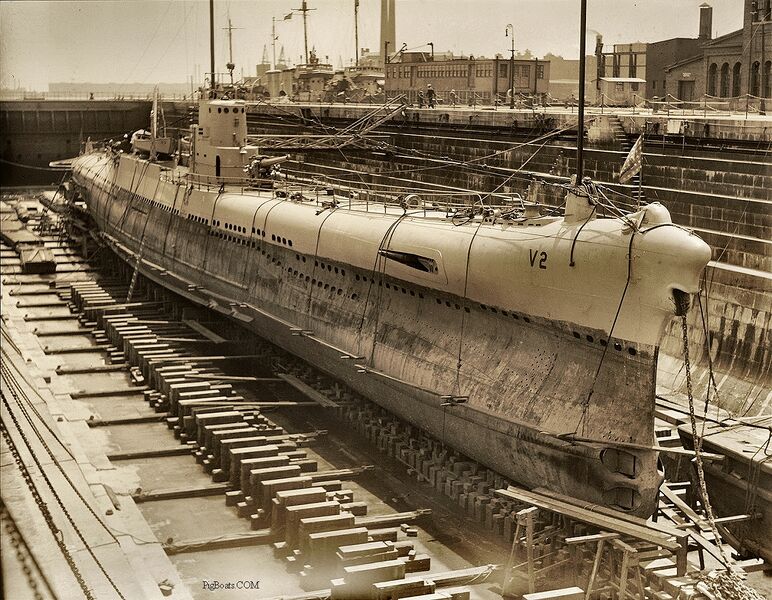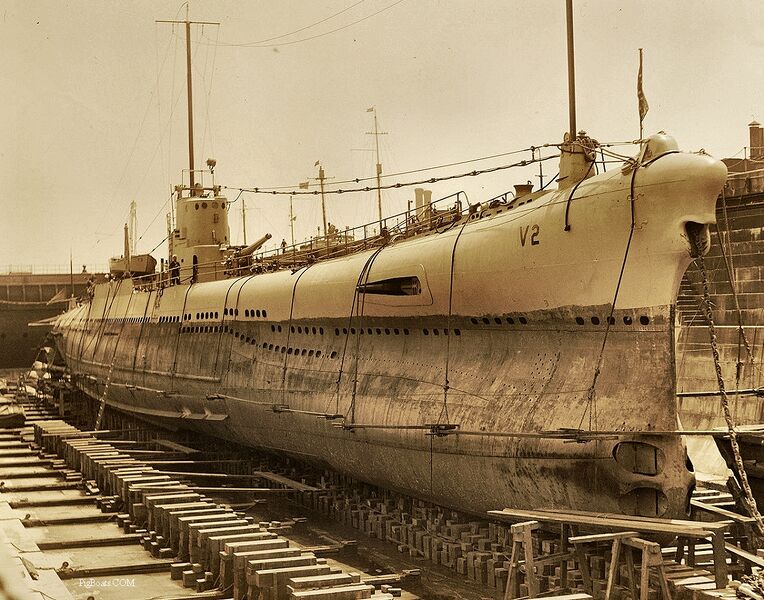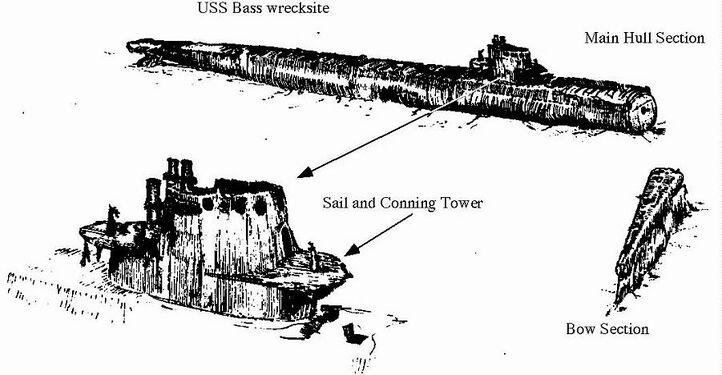V-2: Difference between revisions
Pbcjohnston (talk | contribs) mNo edit summary |
Pbcjohnston (talk | contribs) Added video |
||
| (5 intermediate revisions by 2 users not shown) | |||
| Line 1: | Line 1: | ||
[[File:Header | {{#seo:|title=submarine USS V-2 Bass (SS-164) - PigBoats.COM submarine|title_mode=replace}} | ||
{{#seo:|description=Photographs and pictures of the submarine USS V-2 Bass (SS-164)}} | |||
[[File:New Header V-1 class.jpg]] | |||
{{#ev:youtube|id=D4YG8srlKR8|alignment=left|dimensions=500x300}} | |||
<div style="text-align: justify;"><span style="color:#00008B">Video of V-2 sliding down the ways at the Portsmouth Navy Yard, December 27, 1924. Her oddly shaped figure-eight bow is quite apparent here. | |||
<small>Video from the YouTube British Pathé channel.</small> | |||
[[File:Red bar sub new.jpg]] | |||
[[File:V-2 Provincetown pre-com 1925.jpg|left|500px]] | |||
V-2 at rest during her builder's trials in Cape Cod Bay off Provincetown, MA. in the summer of 1925. The boat is at anchor. Radio technology was still in its infancy and adequate reception and transmission over long ranges required very high radio masts and long aerial antenna wires. These can be seen in this photo, with the thin wires strung between the main radio mast and the fore and aft masts. V-2 also has both of her small boat booms rigged out, with one of her boats in the water alongside. Large propeller guards can be see projecting out from the stern. | |||
<small>Original photo in the private collection of Ric Hedman</small> | |||
[[File:Red bar sub new.jpg]] | |||
[[File:Bass boston 1927-8.jpg|left|500px]] | [[File:Bass boston 1927-8.jpg|left|500px]] | ||
V-2 in drydock at the Boston Navy Yard, Charlestown, MA., probably in the late summer of 1927. The V-2 and her sisters V-1 and V-3 were preparing for a long trip, they were being transferred to the Pacific coast in November 1927 along with Submarine Division 20. In this photo she is firmly down on the keel blocks and she is braced to the dock sidewall. Divers have been in the water to ensure that the boat is resting squarely on the blocks and that none have shifted. The men on the floating platforms are performing a similar function. Emptying the dock is a tricky process and has to be carefully done over several hours to ensure safety. | |||
Of note, on top of the right sidewall are two top masts from the sailing frigate USS Constitution, (Old Ironsides), that had been removed for work while the vessel was also undergoing maintenance at the shipyard. | |||
<small>Photo courtesy of the Boston Public Library, Leslie Jones Collection. Used with permission.</small> | <small>Photo courtesy of the Boston Public Library, Leslie Jones Collection. Used with permission.</small> | ||
| Line 95: | Line 114: | ||
This photo gives a good view of the 3"/50 caliber Mk 17 gun that replaced her original 5"/51 caliber weapon. | This photo gives a good view of the 3"/50 caliber Mk 17 gun that replaced her original 5"/51 caliber weapon. | ||
<small>Original photo in the private collection of Ric Hedman</small> | <small>Original photo in the private collection of Ric Hedman.</small> | ||
[[File:Red bar sub new.jpg]] | |||
[[File:V-2 Bass transits Panama Canal.jpg|left|500px]] | |||
Bass shown transiting one of the lock sets in the Panama Canal, 1942. Bass was assigned to duty in the Canal Zone and made anti-submarine patrols on both the Atlantic and Pacific sides. Her and her sisters were judged to be of little value in the war zone in the western Pacific, but they still retained enough value to conduct these low intensity defensive patrols. To fend off the fierce Panamanian sun, the crew has rigged a canvas awning over the forward deck. Bass would remain in the Canal Zone area until October, 1942 when she returned to the U.S. east coast. | |||
<small>Original photo in the private collection of Ric Hedman.</small> | |||
[[File:Red bar sub new.jpg]] | [[File:Red bar sub new.jpg]] | ||
| Line 105: | Line 131: | ||
</gallery> | </gallery> | ||
</center> | </center> | ||
<div style="text-align: justify;"><span style="color:#00008B">Just nine days after her decommissioning, Bass was expended as a target in a Mk 24 mine test. These two artist drawings depict her wreckage on the bottom of the Atlantic off Block Island. | <div style="text-align: justify;"><span style="color:#00008B">Just nine days after her decommissioning on March 3, 1945, Bass was expended as a target in a Mk 24 mine test. These two artist drawings depict her wreckage on the bottom of the Atlantic off Block Island. | ||
<small>Original drawings by Jim Christley. Used with permission.</small> | <small>Original drawings by Jim Christley. Used with permission.</small> | ||
Latest revision as of 13:25, 8 June 2025
Video from the YouTube British Pathé channel.
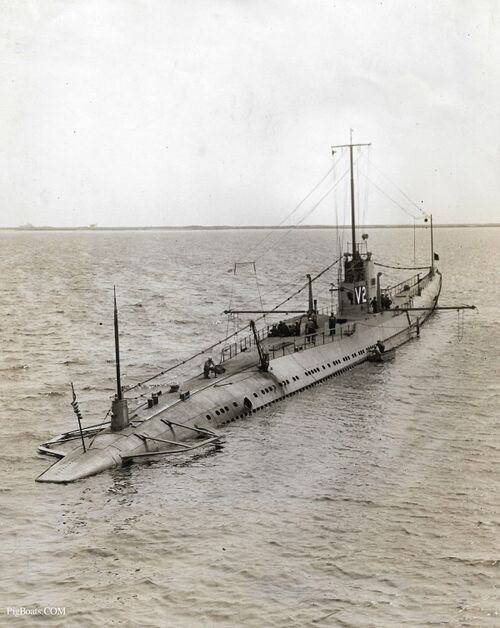
V-2 at rest during her builder's trials in Cape Cod Bay off Provincetown, MA. in the summer of 1925. The boat is at anchor. Radio technology was still in its infancy and adequate reception and transmission over long ranges required very high radio masts and long aerial antenna wires. These can be seen in this photo, with the thin wires strung between the main radio mast and the fore and aft masts. V-2 also has both of her small boat booms rigged out, with one of her boats in the water alongside. Large propeller guards can be see projecting out from the stern.
Original photo in the private collection of Ric Hedman
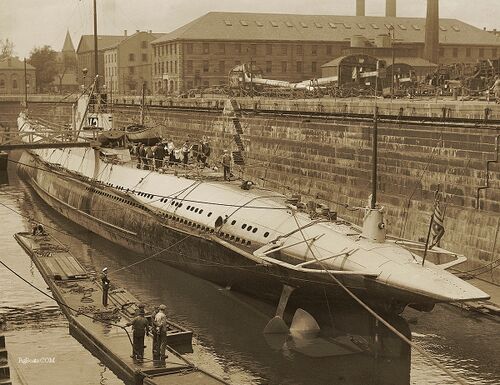
V-2 in drydock at the Boston Navy Yard, Charlestown, MA., probably in the late summer of 1927. The V-2 and her sisters V-1 and V-3 were preparing for a long trip, they were being transferred to the Pacific coast in November 1927 along with Submarine Division 20. In this photo she is firmly down on the keel blocks and she is braced to the dock sidewall. Divers have been in the water to ensure that the boat is resting squarely on the blocks and that none have shifted. The men on the floating platforms are performing a similar function. Emptying the dock is a tricky process and has to be carefully done over several hours to ensure safety.
Of note, on top of the right sidewall are two top masts from the sailing frigate USS Constitution, (Old Ironsides), that had been removed for work while the vessel was also undergoing maintenance at the shipyard.
Photo courtesy of the Boston Public Library, Leslie Jones Collection. Used with permission.
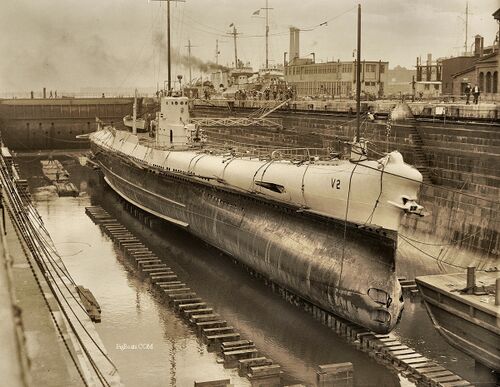
Photo courtesy of the Boston Public Library, Leslie Jones Collection. Used with permission.
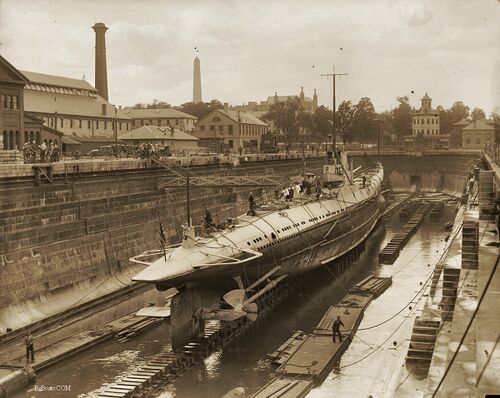
Photo courtesy of the Boston Public Library, Leslie Jones Collection. Used with permission.
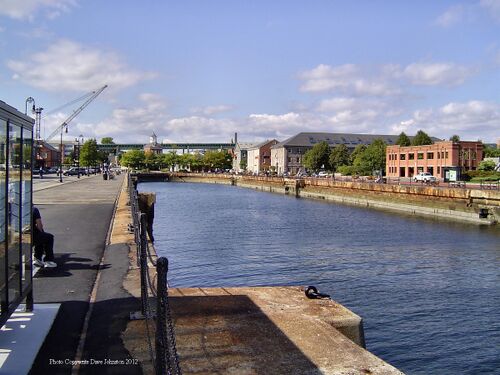
Photo by David Johnston
Also very prominent in these photos are the V-2's small boats, used as liberty launches when the boat was anchored out. These boats were housed in deck fairings aft of the conning tower fairwater and were covered over with teak deck slats. To launch the boats the decking above them would be removed and the boats hoisted out of the fairings using a large kingpost/boom crane, each located just forward of the fairings.
In the first and second photos the undulating sheer of her main deck can be clearly seen.
Photos courtesy of the Boston Public Library, Leslie Jones Collection. Used with permission.
The holes along the side of the boat are "limber holes", used to flood the free flooding superstructure when the boat dives, and drain it upon surfacing. The large slit in the bow houses the retracted starboard side bow diving plane.
Photos courtesy of the Boston Public Library, Leslie Jones Collection. Used with permission.
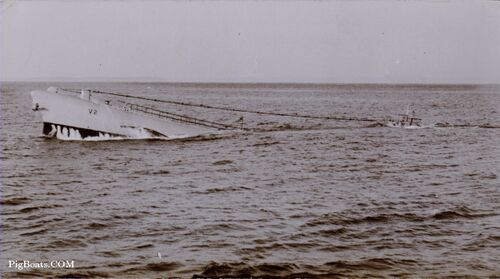
There is nothing else in the photo because it had been physically cropped by the newspaper service that had used the photo. It had much paint and ink on it that had to be removed by webmaster Ric Hedman in order to display the original image as seen here.
Original photo in the private collection of Ric Hedman
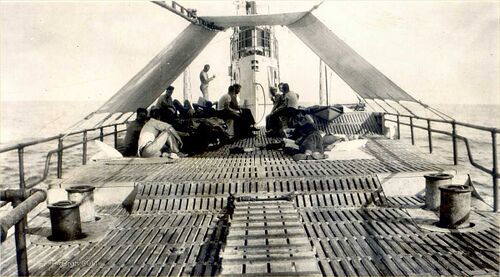
Some of the crew have brought up blankets and pillows to lay on the deck to relax upon. Interesting to note that the bow of the starboard launch is protruding through the decking over the small boat storage locker. The kingposts for launching and retrieving these boats are see at the outer edges of the awning. There is a portable shower rigged on the very back edge of the conning tower fairwater. The hose leading to it can be seen arcing to the right and toward the left.
The bitts seen on either side of the deck in the foreground appear to be retracting. The assumption is based on the fact that each has a handle built into the recessed top of each bitt. It is assumed that turning this handle would unlock or unscrew the bitt from a locked position and allow it to be lowered into the deck. This seems strange to be a strangely contrived attempt at streamlining on a boat with so many other sources of drag topside.
Original photo in the private collection of Ric Hedman
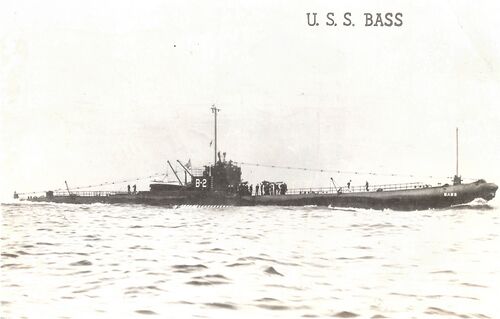
Original photo in the private collection of Ric Hedman

Bass and her sisters were pressed back into service in the fall of 1940 in an effort to plus up the Submarine Force as war loomed. On August 17, 1942 a fire broke out while Bass was at sea. The electrical fire started in the after battery compartment and spread to the motor room and aft torpedo room. Tragically, 25 men died in the fire, nearly 50% of her crew. The Bass was escorted to a port of shelter in Costa Rica, where emergency repairs were made before departing for Balboa in the Canal Zone and eventually a yard period in Philadelphia. Bass continued to serve in a limited capacity until March 3, 1945 when she was decommissioned for the last time.
This photo gives a good view of the 3"/50 caliber Mk 17 gun that replaced her original 5"/51 caliber weapon.
Original photo in the private collection of Ric Hedman.
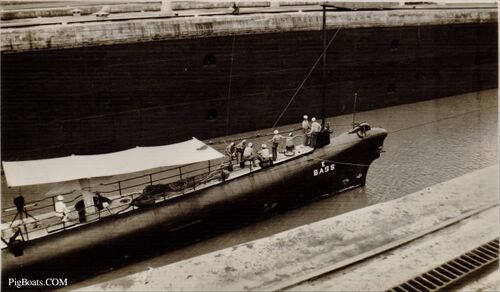
Bass shown transiting one of the lock sets in the Panama Canal, 1942. Bass was assigned to duty in the Canal Zone and made anti-submarine patrols on both the Atlantic and Pacific sides. Her and her sisters were judged to be of little value in the war zone in the western Pacific, but they still retained enough value to conduct these low intensity defensive patrols. To fend off the fierce Panamanian sun, the crew has rigged a canvas awning over the forward deck. Bass would remain in the Canal Zone area until October, 1942 when she returned to the U.S. east coast.
Original photo in the private collection of Ric Hedman.
Original drawings by Jim Christley. Used with permission.
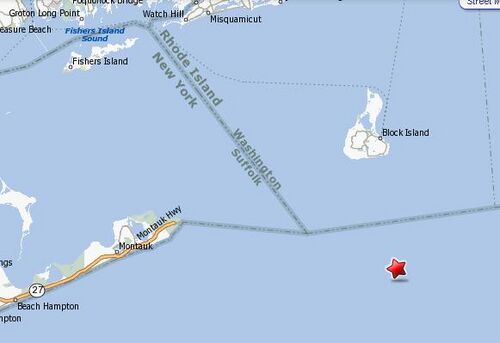
Screen capture by Ric Hedman
Page created by:
Ric Hedman & David Johnston
1999 - 2023 - PigBoats.COM©
Mountlake Terrace, WA, Norfolk, VA
webmaster at pigboats dot com





